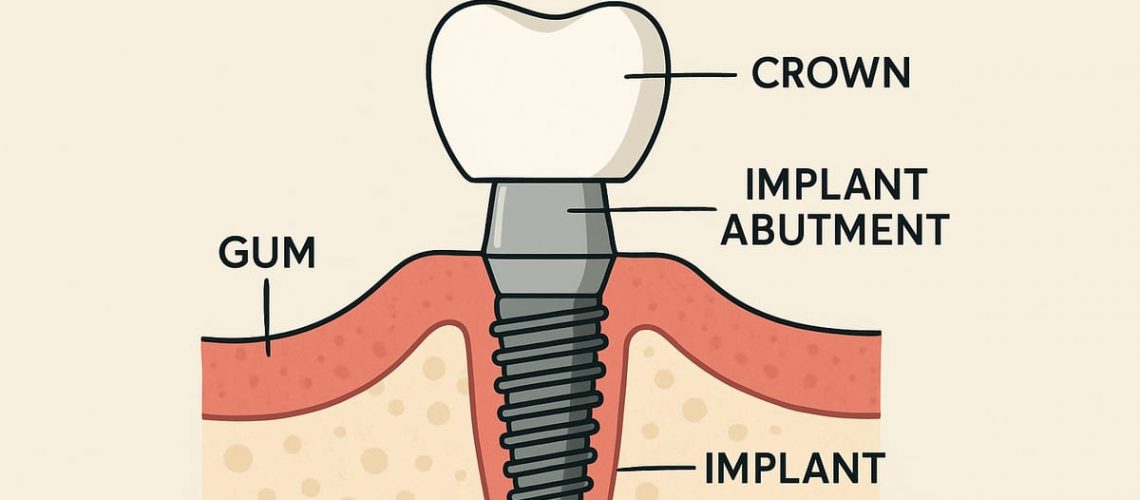What is implant abutment? In plain terms, an implant abutment is the connector piece that joins the buried implant post to the visible tooth replacement (crown, bridge, or denture). It sits between the titanium or ceramic implant in your bone and the final restoration that you see and use every day.
Abutments matter because they support the restoration, shape the gum for a natural look, and transfer bite forces safely to the implant. This guide explains the types of abutments, how they are chosen and placed, what to expect at appointments, how to care for them, and when to seek help.
What Is An Implant Abutment?
An implant abutment is a small component that screws or cements onto the implant. It provides the platform for the crown, bridge, or denture. Key roles of the abutment include:
- Support: holds the prosthetic securely to the implant.
- Emergence profile: shapes how the gum meets the tooth for a natural appearance.
- Force transfer: channels chewing forces into the implant and bone in a safe way.
Types Of Implant Abutments
Stock vs. Custom Abutments
Stock (prefabricated) abutments are ready-made. They are faster and cost less. Custom abutments are made to fit your mouth precisely. Custom abutments are better for angled implants or when esthetics are important because they match your gum and tooth shape.
Materials: Titanium, Zirconia, & Hybrid
Titanium is very strong and biocompatible. It’s often used for back teeth and when strength matters most. Zirconia looks tooth-colored and is great for front teeth where appearance matters. Hybrid abutments combine a titanium base with a zirconia or ceramic outer part to balance strength and esthetics. Each material has trade-offs in strength, gum response, and appearance.
Specialized Abutments
Some abutments are made for specific needs:
- Angulated or multi-unit abutments — for full-arch restorations or when implants are tilted.
- Temporary/provisional abutments — used for healing and same-day provisional teeth.
- Overdenture attachments — for removable implant-supported dentures.
How Abutments Are Selected And Placed
Digital Treatment Planning
Digital tools guide abutment choice and position. CBCT 3D scans, intraoral scans, and Digital Smile Design help the team plan implant angle, depth, and the final tooth shape. Surgical guides made from the plan ensure implants are placed where the abutment and crown will work best.
Surgical vs. Restorative Steps
Some workflows place implants and healing abutments in one stage. Others use a two-stage approach where the implant heals under the gum and the abutment is placed later. Oral surgeons typically place the implant and initial healing cap. The restorative dentist then takes over to fit the final abutment and prosthesis.
Prosthetic Workflow
After healing, the restorative team captures the implant position with an intraoral scan or impression. A provisional restoration can often be placed the same day to test fit and esthetics. Final abutments and crowns are then delivered once the soft tissue and bite are finalized.
What To Expect During An Abutment Appointment
Typical steps at an abutment visit:
- Local anesthesia or sedation options, if needed.
- Removal of the healing cap and cleaning of the site.
- Fit-check of the abutment and provisional restoration.
- Seating and torqueing the final abutment and/or cementing the crown.
Recovery is usually mild. Expect soreness for a few days, controlled with over-the-counter pain meds unless told otherwise. Final crowns may take a few weeks after the abutment is placed, depending on the case.
Caring For Your Implant Abutment & Warning Signs
Daily care keeps the abutment and restoration healthy:
- Brush twice daily with a soft brush.
- Floss or use interdental brushes around the implant.
- Consider a water flosser to flush the gumline.
- Keep regular professional cleanings and X-ray checks to watch bone levels.
Call your dentist if you notice:
- Persistent pain or new pain near the implant.
- Loosening of the abutment, crown, or denture.
- Swelling, pus, ongoing bleeding, or bad taste/odors around the implant.
- Changes in how your bite feels.
Why A Collaborative Implant Team Improves Outcomes
Working with a coordinated oral surgeon and restorative implant dentist improves precision and esthetics. The oral surgeon focuses on safe implant and abutment placement. The restorative dentist designs the abutment and final prosthesis for function and appearance.
At practices that use advanced digital tools — CBCT, intraoral scanners, Digital Smile Design, guided surgery software, and same-day provisional workflows — planning and placement are more predictable. A surgeon with extensive implant and anesthesia experience plus a restorative dentist trained in esthetic and implant prosthetics helps deliver durable, natural results.
Dr. Michael Clark and Dr. Ashkan Haeri combine surgical expertise and restorative esthetic experience to coordinate care, using digital planning, in-house photo and scan tools, and guided surgery to improve outcomes and patient comfort.
Next Steps: Is an Implant Abutment Right For You?
Typical candidates are adults missing one or more teeth, those unhappy with dentures, or patients seeking a stable long-term restoration. A consultation will evaluate your health, bone, gum health, and cosmetic goals.
To request a virtual consult or an in-office evaluation, prepare to share recent photos, medical history, a list of medications, and any past dental X-rays if available. Many offices offer a free virtual smile mock-up from a photo to start the conversation. Schedule a consult to learn if an implant and the right abutment are a fit for your needs.

